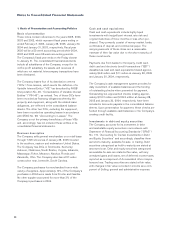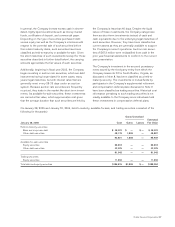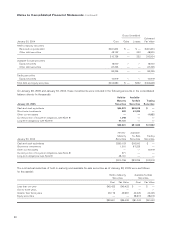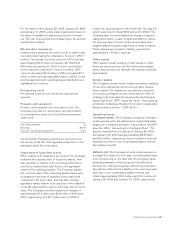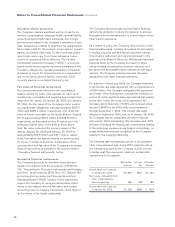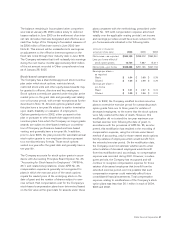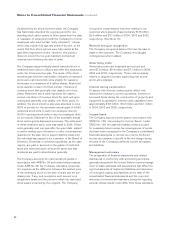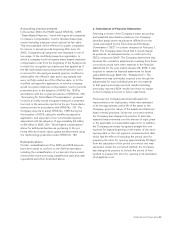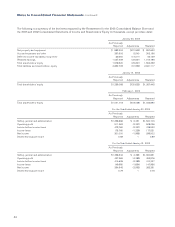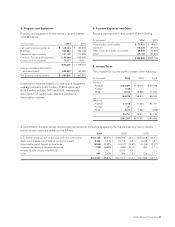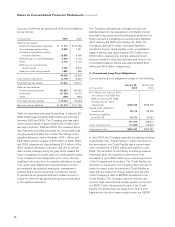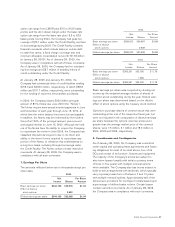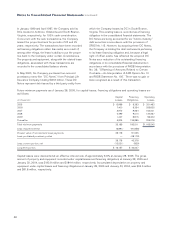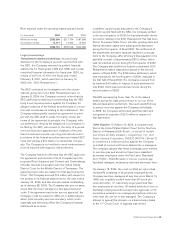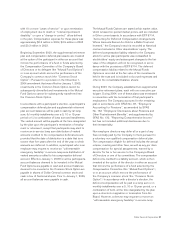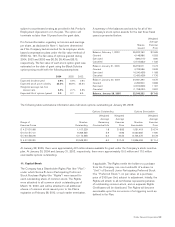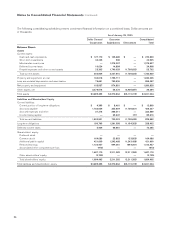Dollar General 2004 Annual Report Download - page 48
Download and view the complete annual report
Please find page 48 of the 2004 Dollar General annual report below. You can navigate through the pages in the report by either clicking on the pages listed below, or by using the keyword search tool below to find specific information within the annual report.
46
Notes to Consolidated Financial Statements (continued)
Sources of deferred tax assets and deferred tax liabilities
are as follows:
(In thousands) 2004 2003
Deferred tax assets:
Deferred compensation expense $ 17,310 $ 20,466
Accrued expenses and other 8,889 7,521
Workers compensation-related
insurance liabilities 25,950 9,198
Deferred gain on sale/leasebacks 2,624 2,775
Other 3,755 4,105
State tax net operating loss
carryforwards 9,180 9,916
State tax credit carryforwards 1,982 1,568
69,690 55,549
Less valuation allowance (2,126) (2,232)
Total deferred tax assets 67,564 53,317
Deferred tax liabilities:
Property and equipment (82,807) (60,091)
Inventories (31,635) (14,017)
Other (599) (935)
Total deferred tax liabilities (115,041) (75,043)
Net deferred tax liabilities $ (47,477) $ (21,726)
State net operating loss carryforwards as of January 28,
2005 totaled approximately $223 million and will expire
between 2005 and 2024. The Company also has state
credit carryforwards of approximately $3.0 million that
will expire between 2006 and 2016. The valuation allow-
ance has been provided principally for certain state loss
carryforwards and state tax credits. The change in the
valuation allowance was a decrease of $0.1 million and
$0.6 million and an increase of $0.5 million in 2004, 2003,
and 2002, respectively. Approximately $1.0 million of the
2003 valuation allowance reduction was due to certain
state tax law changes during the year which caused the
future recognition of certain state tax credit carryforwards
to be considered more likely than not to occur, thereby
resulting in the reduction of a valuation allowance created
in an earlier year. Based upon expected future income
and available tax planning strategies, management
believes that it is more likely than not that the results
of operations will generate sufficient taxable income to
realize the deferred tax assets after giving consideration
to the valuation allowance.
The Company estimates its contingent income tax
liabilities based on its assessment of probable income
tax-related exposures and the anticipated settlement of
those exposures translating into actual future liabilities.
As of January 28, 2005 and January 30, 2004, the
Company’s accrual for these contingent liabilities,
included in Income taxes payable in the consolidated
balance sheets, was approximately $13.5 million and
$16.9 million, respectively, and the related accrued
interest included in Accrued expenses and other in the
consolidated balance sheets was approximately $6.9
million and $6.6 million, respectively.
6. Current and Long-Term Obligations
Current and long-term obligations consist of the following:
(In thousands)
January 28,
2005
January 30,
2004
85⁄8% Notes due June 15, 2010,
net of discount of $232 and
$275, at January 28, 2005
and January 30, 2004,
respectively $199,768 $199,725
Capital lease obligations
(see Note 8) 28,178 38,228
Financing obligations
(see Note 8) 43,376 44,054
271,322 282,007
Less: current portion (12,860) (16,670)
Long-term portion $258,462 $265,337
In June 2004, the Company amended its existing revolving
credit facility (the “Credit Facility”). Under the terms of
the amendment, the Credit Facility has a current maxi-
mum commitment of $250 million and expires in June
2009. The amended Credit Facility contains provisions
that would allow the maximum commitment to be
increased to up to $400 million upon mutual agreement
of the Company and its lenders. The Credit Facility, as
amended, is unsecured. The Company pays interest on
funds borrowed under the amended Credit Facility at
rates that are subject to change based upon the ratio
of the Company’s debt to EBITDA (as defined in the
Credit Facility). The Company has two interest rate
options, base rate (which is usually equal to prime rate)
or LIBOR. Under the amended terms of the Credit
Facility, the facility fees can range from 12.5 to 37.5
basis points; the all-in drawn margin under the LIBOR


